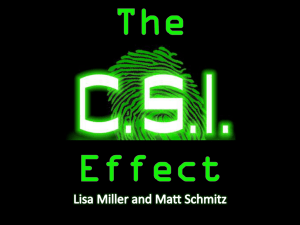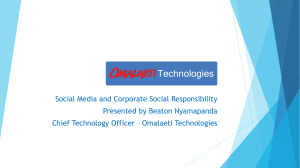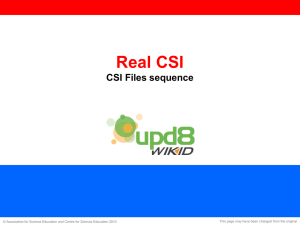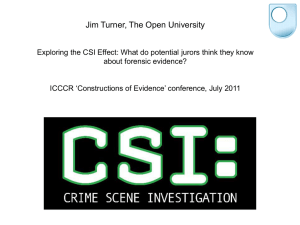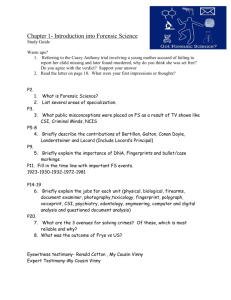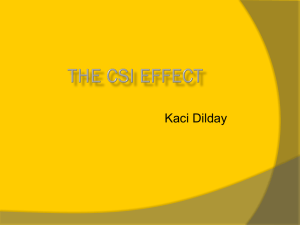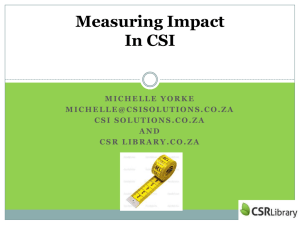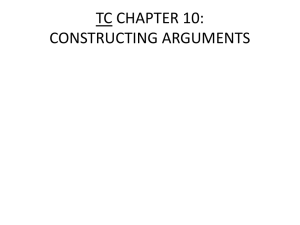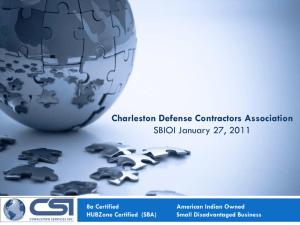USA Today:CSI Effect Article Link (Word doc)
advertisement
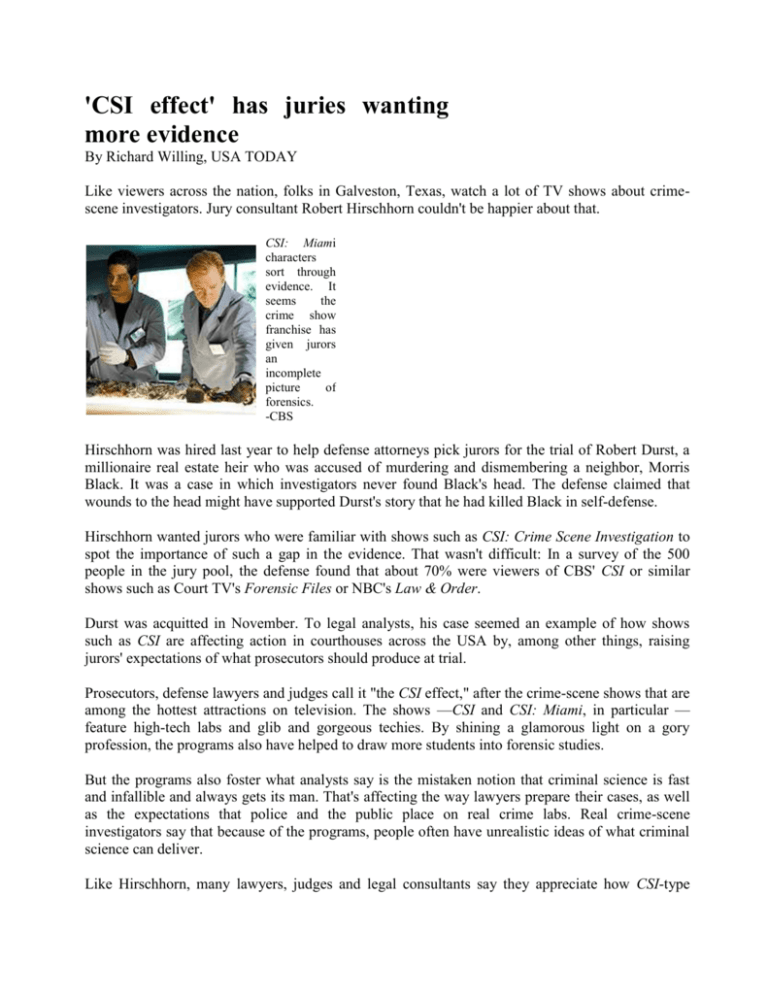
'CSI effect' has juries wanting more evidence By Richard Willing, USA TODAY Like viewers across the nation, folks in Galveston, Texas, watch a lot of TV shows about crimescene investigators. Jury consultant Robert Hirschhorn couldn't be happier about that. CSI: Miami characters sort through evidence. It seems the crime show franchise has given jurors an incomplete picture of forensics. -CBS Hirschhorn was hired last year to help defense attorneys pick jurors for the trial of Robert Durst, a millionaire real estate heir who was accused of murdering and dismembering a neighbor, Morris Black. It was a case in which investigators never found Black's head. The defense claimed that wounds to the head might have supported Durst's story that he had killed Black in self-defense. Hirschhorn wanted jurors who were familiar with shows such as CSI: Crime Scene Investigation to spot the importance of such a gap in the evidence. That wasn't difficult: In a survey of the 500 people in the jury pool, the defense found that about 70% were viewers of CBS' CSI or similar shows such as Court TV's Forensic Files or NBC's Law & Order. Durst was acquitted in November. To legal analysts, his case seemed an example of how shows such as CSI are affecting action in courthouses across the USA by, among other things, raising jurors' expectations of what prosecutors should produce at trial. Prosecutors, defense lawyers and judges call it "the CSI effect," after the crime-scene shows that are among the hottest attractions on television. The shows —CSI and CSI: Miami, in particular — feature high-tech labs and glib and gorgeous techies. By shining a glamorous light on a gory profession, the programs also have helped to draw more students into forensic studies. But the programs also foster what analysts say is the mistaken notion that criminal science is fast and infallible and always gets its man. That's affecting the way lawyers prepare their cases, as well as the expectations that police and the public place on real crime labs. Real crime-scene investigators say that because of the programs, people often have unrealistic ideas of what criminal science can deliver. Like Hirschhorn, many lawyers, judges and legal consultants say they appreciate how CSI-type shows have increased interest in forensic evidence. "Talking about science in the courtroom used to be like talking about geometry — a real jury turnoff," says Hirschhorn, of Lewisville, Texas. "Now that there's this almost obsession with the (TV) shows, you can talk to jurors about (scientific evidence) and just see from the looks on their faces that they find it fascinating." But some defense lawyers say CSI and similar shows make jurors rely too heavily on scientific findings and unwilling to accept that those findings can be compromised by human or technical errors. Prosecutors also have complaints: They say the shows can make it more difficult for them to win convictions in the large majority of cases in which scientific evidence is irrelevant or absent. "The lesson that both sides can agree on is, what's on TV does seep into the minds of jurors," says Paul Walsh, chief prosecutor in New Bedford, Mass., and president of the National District Attorneys Association. "Jurors are going to have information, or what they think is information, in mind. That's the new state of affairs." Lawyers and judges say the CSI effect has become a phenomenon in courthouses across the nation: • In Phoenix last month, jurors in a murder trial noticed that a bloody coat introduced as evidence had not been tested for DNA. They alerted the judge. The tests hadn't been needed because the defendant had acknowledged being at the murder scene. The judge decided that TV had taught jurors about DNA tests, but not enough about when to use them. • Three years ago in Richmond, Va., jurors in a murder trial asked the judge whether a cigarette butt found during the investigation could be tested for links to the defendant. Defense attorneys had ordered DNA tests but had not yet introduced them into evidence. The jury's hunch was correct — the tests exonerated the defendant, and the jury acquitted him. • In Arizona, Illinois and California, prosecutors now use "negative evidence witnesses" to try to assure jurors that it is not unusual for real crime-scene investigators to fail to find DNA, fingerprints and other evidence at crime scenes. • In Massachusetts, prosecutors have begun to ask judges for permission to question prospective jurors about their TV-watching habits. Several states already allow that. • Last year in Wilmington, Del., federal researchers studying how juries evaluate scientific evidence staged dozens of simulated trials. At one point, a juror struggling with especially complicated DNA evidence lamented that such problems never come up "on CSI." The CSI effect also is being felt beyond the courtroom. At West Virginia University, forensic science is the most popular undergraduate major for the second year in a row, attracting 13% of incoming freshmen this fall. In June, supporters of an Ohio library drew an overflow crowd of 200-plus to a luncheon speech on DNA by titling it "CSI: Dayton." The Los Angeles County Sheriff's Department crime lab has seen another version of the CSI effect. Four technicians have left the lab for lucrative jobs as technical advisers to crime-scene programs. "They found a way to make science pay," lab director Barry Fisher says. Shows' popularity soars CSI, which begins its fifth season next month, was America's second-most-popular TV program during the season that began last fall, after the Tuesday edition of American Idol. CSI and a spinoff, CSI: Miami (which is about to begin its third season), have drawn an average of more than 40 million viewers a week during the past TV season. Law & Order, whose plots sometimes focus on forensic evidence, has been the 13th-most-watched show during the 2003-04 season, averaging about 15 million viewers. On cable, the Discovery Channel, A&E and Court TV have programs that highlight DNA testing or the analysis of fingerprints, hair and blood-spatter patterns. CSI: NY, set in New York City, is slated to premiere next month. The CSI shows combine whiz-bang science with in-your-face interrogations to solve complex crimes. Some sample dialogue from actor David Caruso, the humorless monotone who plays investigator Horatio Caine on CSI: Miami: "He (the bad guy) doesn't know how evidence works, but you know what? He will." The shows' popularity, TV historians say, is partly a result of their constant presence. Counting network and cable, at least one hour of crime-forensics programming airs in prime time six nights a week. The stars of the shows often are the equipment — DNA sequencers, mass spectrometers, photometric fingerprint illuminators, scanning electron microscopes. But the technicians run a close second. "It's 'geek chic,' the idea that kids who excel in science and math can grow up to be cool," says Robert Thompson, who teaches the history of TV programming at Syracuse University. "This is long overdue. ... Cops and cowboys and doctors and lawyers have been done to death." Departing from reality Some of the science on CSI is state-of-the-art. Real lab technicians can, for example, lift DNA profiles from cigarette butts, candy wrappers and gobs of spit, just as their Hollywood counterparts do. But some of what's on TV is far-fetched. Real technicians don't pour caulk into knife wounds to make a cast of the weapon. That wouldn't work in soft tissue. Machines that can identify cologne from scents on clothing are still in the experimental phase. A criminal charge based on "neurolinguistic programming" — detecting lies by the way a person's eyes shift — likely would be dismissed by a judge. But real scientists say CSI's main fault is this: The science is always above reproach. "You never see a case where the sample is degraded or the lab work is faulty or the test results don't solve the crime," says Dan Krane, president and DNA specialist at Forensic Bioinformatics in Fairborn, Ohio. "These things happen all the time in the real world." Defense lawyers say the misconception that crime-scene evidence and testing are always accurate helps prosecutors. "Jurors expect the criminal justice system to work better than it does," says Betty Layne DesPortes, a criminal defense lawyer in Richmond, Va., who has a master's degree in forensic science. She notes that during the past 15 years, human errors and corruption have skewed test results in crime labs in West Virginia, Pennsylvania, California, Texas and Washington state. But prosecutors say the shows help defense lawyers. Jurors who are regular viewers, they say, expect testable evidence to be present at all crime scenes. In fact, they say, evidence such as DNA and fingerprints — the staple of CSI plots — is available in only a small minority of cases and can yield inconclusive results. "Defense attorneys will get up there and bang the rail and say 'Where were the DNA tests?' to take advantage of the idea that's in the juror's mind," says Joshua Marquis, a prosecutor in Astoria, Ore. "You've got to do a lot of jury preparation to defeat that." Some prosecutors have gone to great lengths to lower jurors' expectations about such evidence. In Belleville, Ill., last spring, prosecutor Gary Duncan called on seven nationally recognized experts to testify about scientific evidence against a man accused of raping and murdering a 10-year-old girl. The witnesses included specialists in human and animal DNA, shoe-print evidence, population statistics and human mitochondrial DNA, genetic material that is inherited only from one's mother and that seldom is used in criminal cases. Duncan won a conviction. "I wanted to be certain the jury was clear on the evidence and its meaning," he says. "These days, juries demand that." CSI producers acknowledge that they take some liberties with facts and the capabilities of science, but they say it's necessary to keep their story lines moving. Elizabeth Devine, a former crime lab technician who writes and produces episodes of CSI: Miami, spoke at a training seminar for prosecutors last year in Columbia, S.C. She said that if the shows did not cut the time needed to perform DNA tests from weeks to minutes, a villain might not be caught before "episode five." For all of CSI's faults, some lab technicians say they have a soft spot for the TV version of their world. "It's great for getting people interested (in) careers" in forensic science, says Barbara Llewellyn, director of DNA analysis for the Illinois State Police. Terry Melton, president of Mitotyping Technologies in State College, Pa., says the programs have made "jury duty something people now look forward to." And Fisher says the shows have given "science types" like himself some unexpected cachet. "When I tell someone what I do, I never have to explain it now," he says. "They know what a crimescene (technician) does. At least, they think they do."
